Revision Notes: The First War of Independence - 1857 | History for SSS 2 PDF Download
| Table of contents |

|
| Introduction |

|
| Main Events of the Revolt |

|
| Consequences of the Revolt |

|
| Limitations of the Revolt of 1857 |

|
| Nature of the Revolt |

|
Introduction
The Revolt of 1857 was a significant uprising against British rule in India, triggered by various political, economic, and social factors. It marked a turning point in Indian history, reflecting widespread discontent and resistance to colonial authority.
Political Causes
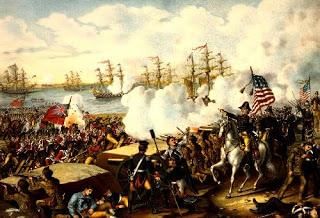
The political causes of the Revolt of 1857 are as follows:
- Policy of Expansion: Following the Battle of Plassey, the British rapidly expanded their control over Indian territories through wars, the Doctrine of Lapse, the Subsidiary Alliance System, and claims of mismanagement by Indian rulers. By 1856, most kingdoms were under British rule, either directly or indirectly, with Indian princes reduced to puppet rulers. This bred resentment among both kings and their subjects.
- Doctrine of Lapse: Introduced by Lord Dalhousie, this policy stated that if an Indian ruler died without a male heir, his kingdom would be annexed by the British. This led to the annexation of states like Jhansi, Satara, and Nagpur, provoking rulers such as Rani Laxmibai to revolt.
- Annexation of Awadh: Lord Dalhousie annexed Awadh, claiming mismanagement, which was seen as arbitrary and a breach of promises to Indian chiefs. This decision angered both rulers and the general populace.
- Disrespect towards Bahadur Shah Zafar: The last Mughal ruler, Bahadur Shah Zafar, was treated disrespectfully by the British. Lord Dalhousie’s decision to remove Zafar and his family from the Red Fort, and the removal of Zafar’s name from British coins insulted Indian sentiments. Lord Canning’s declaration of Zafar as the last Mughal king and the denial of royal status to his descendants further fueled anger against British rule.
- Treatment of Nana Saheb and Rani Laxmibai: Nana Saheb, the adopted son of the last Peshwa Baji Rao II, was denied a pension by the British, causing outrage in the Maratha community. Rani Laxmibai became a staunch opponent of the British after her kingdom of Jhansi was annexed under the Doctrine of Lapse.
Socio-Religious Causes
- Interference with Social Customs: The British made attempts to reform certain social practices in India, such as banning sati in 1829 and passing the Widow Remarriage Act in 1856. However, Indians resented this interference in their social customs.
- Policy of Racial Discrimination: The British exhibited a policy of racial discrimination, believing in their superiority over Indians. This led to contemptuous treatment of Indians, who were often ill-treated and insulted.
- Laws of Property: In 1850, a law was enacted that allowed Indians who converted to Christianity to inherit ancestral property. Indians perceived this as a ploy by the British to promote conversions to Christianity.
- Activities of the Missionaries: The early nineteenth century saw an increase in the activities of missionaries, which fueled the belief among Indians that the government was supporting efforts to convert them to Christianity.
- Taxing Religious Institutions: The British implemented taxes on lands owned by temples and mosques. This affected families dependent on these lands, leading to the perception that the British were undermining religions in India.
Economic Causes of Revolt of 1857
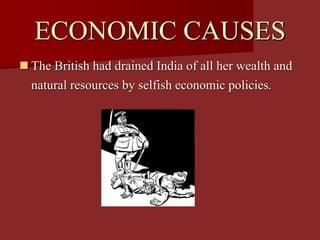
- Exploitation of Economic Resources: The British exploited India's resources by forcing the country to export raw materials at very low prices. They exported plantation products and food grains to Britain while imposing high import duties on Indian goods. This led to the decline of handicrafts and subsidiary industries in India.
- Drain of Wealth: The British began draining Indian wealth by purchasing raw materials for export to England using Indian revenues. Salaries and pensions of British officers were also paid from Indian revenues, marking the start of wealth transfer from India to Britain.
- Decay of Cottage and Handicraft Industries: The Indian handicraft industry declined due to the free trade policy of the British. Indian goods couldn’t compete with cheap British machine-made products, and high trade duties on Indian goods entering Britain worsened the situation, leading to the loss of livelihoods for many artisans and weavers.
- Exploitation of the Indian Peasantry: The British imposed high taxes on Indian peasants, significantly raising land revenues in regions like Bengal. Many peasants were forced to sell their lands, and the new landowners, including traders and moneylenders, neglected land improvement, worsening the condition of the Indian peasantry.
- Poverty and Famine: British economic policies led to widespread poverty in India, with recurrent famines occurring. The British did little to alleviate the impact of these famines on the Indian population.
- Decline of Landed Aristocracy: The landed aristocracy, including taluqdars and hereditary landlords, lost their estates under the Inam Commission of 1852. About 20,000 estates were confiscated and auctioned to the highest bidders, with landed rights in Awadh also revoked.
Mangal Pandey was executed for refusing to use the greased cartridges, which sparked the revolt.
Military Causes of the 1857 Revolt
- Ill-treatment of Indian Soldiers: The British government treated Indian soldiers poorly. They were denied better pay and facilities, and were often humiliated by English officers. No Indian soldier could rise above the rank of ‘subedar’ in the Indian army, and the British had no regard for Indian sentiments.
- General Service Enlistment Act: In 1856, the Company passed a law requiring sepoys to travel overseas whenever the Company needed them. Hindus believed that crossing the seas could cause them to lose their caste and religion, leading the sepoys to think the Company was trying to undermine their faith.
- Larger Proportion of Indians in the British Army: The British army had a larger number of Indian soldiers, making it easier for Indian soldiers to rebel against the British.
- Deprivation of Allowances: The Post Office Act of 1854 removed the privilege of free postage for sepoys. They were also required to serve in areas far from their homes without extra pay or foreign service allowance, which angered Indian soldiers.
- Low Salaries: Indian soldiers received very low wages that were insufficient to support their families, while British soldiers earned higher salaries.
Immediate Cause
The British introduced a new rifle called the 'Enfield Rifle' to their army, which required a cartridge with a greased paper cover. This cover had to be bitten off before loading the cartridge into the rifle. Rumours spread that the grease used was made from beef and pork, offending the religious beliefs of the soldiers. Mangal Pandey, a soldier, protested against the use of the rifle, believing it was an attack on their faith. On March 29, 1857, he attacked his officers in Barrackpore and was subsequently hanged.
On May 9, 1857, eighty-five Indian soldiers who refused to use the greased cartridges were dismissed and jailed for disobeying orders. This incident sparked the sepoy revolt in Meerut, which quickly spread to other parts of northern India.
Main Events of the Revolt
The main centres of the revolt were
Delhi
- The sepoys in Meerut were joined by the local soldiers in Delhi. They killed many British officers and declared Bahadur Shah Zafar as the leader of the revolt.
- Later, General Bakht Khan led the Bareilly troops into Delhi and provided leadership to the rebels.
- After Delhi was recaptured by troops led by Sir John Nicholson, Bahadur Shah Zafar was found guilty of aiding the rebellion. His sons and grandson were killed, and he was exiled to Yangon in Myanmar.
Awadh
- A major uprising occurred in Awadh on 30 May 1857. Within a few days, the entire region of Awadh was under the control of the rebels.
- Begum Hazrat Mahal emerged as the leader of the revolt in Awadh. After the British recaptured the city, she fled to Nepal.
Kanpur
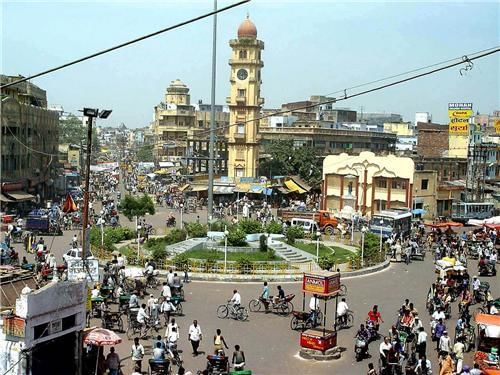
- In Kanpur, the revolt was led by Nana Sahib. An enraged mob captured and killed a large number of English men, women, and children.
- However, Nana Sahib was defeated by the British in December 1857. He fled to Nepal, where he eventually died.
Jhansi
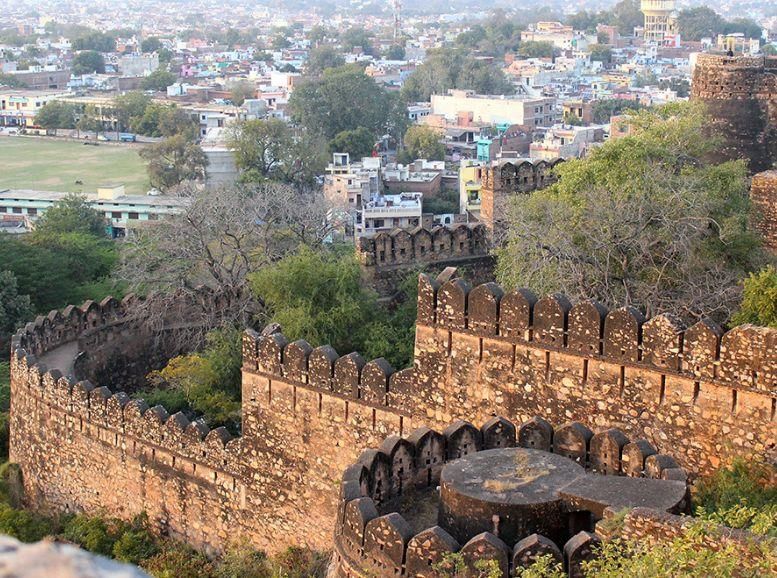
- In Jhansi, the revolt was spearheaded by Rani Laxmibai. Her state had been annexed by Lord Dalhousie under the Doctrine of Lapse, prompting her to rise against the British and join the revolt.
- By June 1857, the English had lost control over significant parts of Jhansi. When English forces led by Hugh Rose besieged the fort of Jhansi, Laxmibai fought valiantly against them. However, when holding the fort became impossible, she made a swift escape to Kalpi.
- Rani Laxmibai emerged as a prominent figure in the 1857 Indian rebellion. At Kalpi, she joined forces with Tantya Tope, the commander of Nana Sahib's forces, and together they marched towards Gwalior.
- Unfortunately, Rani Laxmibai was overwhelmed by the large number of British troops and was killed in battle. Tantya Tope managed to escape but was later captured and killed by the British.
Other centres of the revolt included Bareilly and Arrah in Bihar. In Bareilly, the revolt was led by Khan Bahadur Khan, while in Bihar, it was led by Kunwar Singh, an elderly zamindar. Maulvi Ahmadullah led the revolt in Faizabad.
Consequences of the Revolt
The revolt of 1857 was brutally suppressed by the British and had far-reaching effects on India’s socio-political life.
End of the Company’s Rule
- The British Crown took over the governance of India from the Company.
- The Board of Directors and the Board of Control for India were abolished.
- A new position, the Secretary of State for India, was created to oversee British policies in India. This official's salary and allowances were to be paid from Indian revenues.
- The Governor-General in India was renamed the Viceroy of India. Lord Canning became the first Viceroy.
Proclamation of Queen Victoria
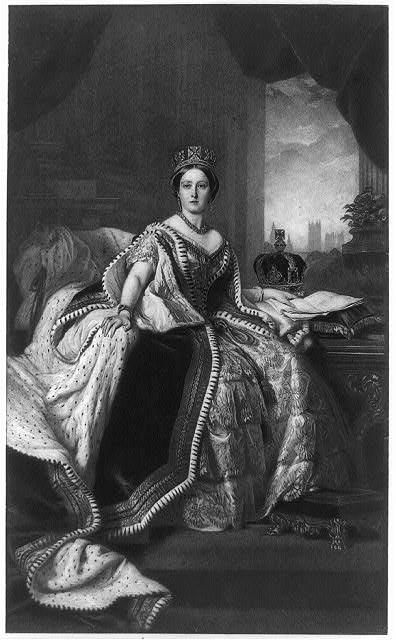
- After the 1857 revolt, control of Indian territories was transferred from the Company to the Crown.
- Queen Victoria's Proclamation promised:
- Non-intervention in Indians' social and religious matters.
- Equal treatment for European and Indian subjects.
- Pardon for Indians involved in the revolt, except those guilty of murdering British citizens.
- Promotion of Indian industries.
End of the Mughals and Peshwaship
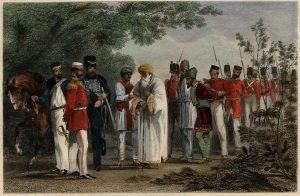
After the revolt, the sons and grandchildren of Bahadur Shah Zafar were executed. The Mughal Empire in India officially ended with the death of Bahadur Shah Zafar. Similarly, after Nana Sahib fled to Nepal following the revolt, the institution of Peshwaship also came to an end. This marked the downfall of two of the British's most formidable enemies during the revolt.
Relations with the Princely States
The British abandoned the Doctrine of Lapse and the Subsidiary Alliance System. The loyalty of the Indian princes during the revolt was rewarded.
Policy of Divide and Rule
As both Hindus and Muslims had participated in the revolt, the British began to follow the policy of divide and rule. They not only created a rift between the Hindus and the Muslims but also between castes and various groups.
Racial Discrimination

The British treated Indians with contempt and humiliation, considering them untrustworthy. Public facilities such as railway compartments, parks, hotels, and clubs were reserved solely for the British.
Changes in the Structure of the Army
- The British increased the strength of European troops in India and stationed them in key strategic locations. Artillery was placed under British control, and recruitment in the army was discriminated against based on caste, region, and religion to prevent any anti-British uprising.
- To avoid any kind of mutiny, newspapers, journals, and nationalist publications were prevented from reaching the soldiers.
Emergence of Nationalism
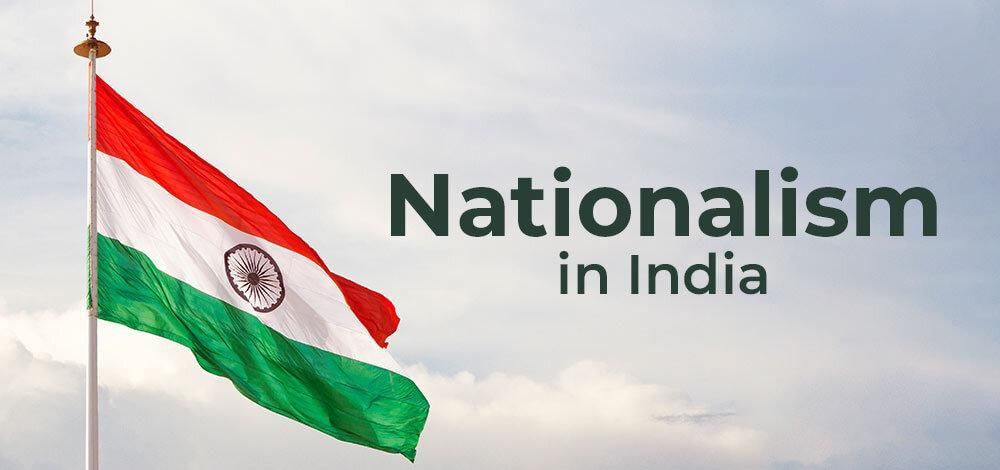
The revolt of 1857, despite its failure, played a crucial role in awakening the spirit of nationalism among Indians. The bravery and determination of leaders like Rani Laxmibai, Nana Sahib, and Tantya Tope in their fight against British rule became a source of inspiration for countless Indians. Their struggle highlighted the injustices of colonial rule and motivated others to join the fight for independence.
Limitations of the Revolt of 1857
- Limited Spread: The revolt was not widespread and did not affect the western, eastern, and southern parts of India.
- Lack of Modern Weapons: Indian rebels were not equipped with modern weapons and lacked organisation and planning, while the British soldiers were well-armed with advanced weaponry.
- Non-participation of Rulers: Many rulers, such as the Sindhias of Gwalior, the Nizam of Hyderabad, the Holkars of Indore, and the rulers of Patiala, did not participate in the revolt.
- Lack of Support from Zamindars and Moneylenders: Many zamindars and moneylenders did not support the uprising.
- Opposition from Educated Indians: Some educated Indians believed that India could only be modernised under British rule and did not support the revolt.
Nature of the Revolt
- A revolt is an uprising against unjust or unfair policies imposed by rulers. Historians have differing views on the nature of the revolt of 1857.
- British Historians: Historians like P. E. Roberts view the revolt as a military mutiny primarily led by Indian sepoys.
- Indian Historians: Many Indian historians, including Veer Savarkar, see the revolt as a national uprising against British policies, involving not just sepoys but also peasants, zamindars, and rulers.
- Savarkar referred to it as the ‘First War of Indian Independence,’ highlighting its broader scope beyond a military mutiny.
Conclusion: The revolt was more than a mutiny; it was an uprising against British rule, spreading across north and central India. However, it did not impact large parts of India, and the idea of nationalism had not yet fully developed. Hence, it is more accurately described as an Indian uprising against British policies.
|
81 docs|6 tests
|
FAQs on Revision Notes: The First War of Independence - 1857 - History for SSS 2
| 1. What were the main political causes of the Revolt of 1857? |  |
| 2. How did socio-religious factors contribute to the Revolt of 1857? |  |
| 3. What were the significant events that took place in Awadh during the Revolt of 1857? |  |
| 4. What were the consequences of the Revolt of 1857 for British rule in India? |  |
| 5. How did racial discrimination manifest in British policies during the time of the Revolt of 1857? |  |















